
|
1 - Mr. d’Herman filed in 1713 the first patent of track at the Royal Academy of Sciences. It was a series of interconnected rollers. Pict from book of Jean Noulin : 'Histoire des tracteurs à chenilles en France', ETAI, 92100 Boulogne , 1997.
|
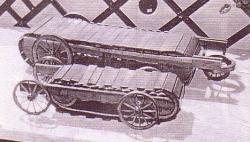
|
2 - Richard Lowell Edgeworth, English writer and inventor (1744-1817) patented in 1770 a steam engine that could travel on ‘a rail system without end '. It’s Edgeworth himself, seeking possible prior to his invention, which discovered the Memory of d’Herman.
It can be seen on the picture the scaled model of wood and copper 'Chenittes' from the late 18th century, i.e. contemporary of Edgeworth.
Others as George Cayley in 1828, Joseph Maria Hoene-Wronski in 1830 and Dimitry Zagryazhsky in 1837 also filed patents.
|
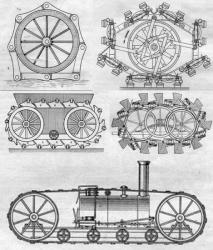
|
3 - Many patents of caterpillars were filed again in the major industrial countries. Among them : Lewis Bompers, André Dunlop, Clarke, Catley, Welch, Heathcoat and Stewart in 1892. This highly sought displacement mechanism stimulated imaginations. Pict. from Internet
|

|
4 - Clement Ader, the father of aviation, also invented an ‘endless rail’, whose patent date of 1866. Practically, it was fitted to a trolley for children two bands in braided camel hair reducing rolling resistance and pulled by only two goats instead of twelve in the sand at the Jardin des Tuileries.
Pict from book of Jean Noulin : 'Histoire des tracteurs à chenilles en France', ETAI, 92100 Boulogne , 1997.
|
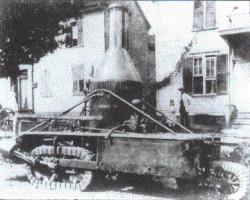
|
5 - Many caterpillars began to be built : the precursor Minnis exposed that steam chain tractor in Ames, Iowa in 1869.
Pict from book of Jean Noulin : 'Histoire des tracteurs à chenilles en France', ETAI, 92100 Boulogne, 1997.
|
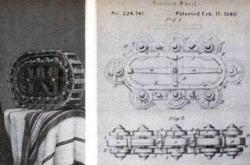
|
6 - In 1873, Henry T. Stith, Ottawa, Kansas invented this caterpillar he did make but the lack of engine did not allow him to take full advantage.
He however outfitted horse-drawn carriage he exhibited at the fair in Kansas City in 1879. He also turned a bicycle for his son but high rolling resistance required a strength certainly too high. Pict from Popular Science June 1944.
|
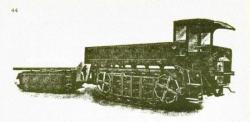
|
7 - Stratton realized a steam chains tractor in 1893. Others build Diplock Pedrial Tractor and Trailer in 1913 (photo), Cropton Overgrown Pedrial Landship Chassis in 1915, Bullock Creeping Grip circa 1914, Killen-Strait in 1915. Pict from Journal of Terramechanics, Vol 1, N°1, 1964, by C.J.Nuttal Jr, edited by A. R. Reece, University of New Casttle, GB for International Society for Terrain Vehicle System (ISTVS).
|
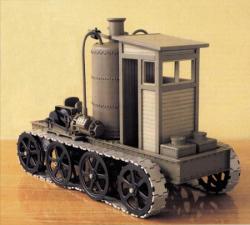
|
8 - Fyodor Blinov Abramovich (1827-1902) took 10 years to build his tractor and presented it in Nizhny Novgorod, Russia, in 1896. It had two steam engines, one per track, thus removing the steering wheel. No one was interested in his invention during 10 years after his death. Pict Internet.
|
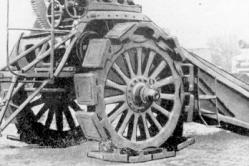
|
9 - Waiting for the boom crawler, James Boydell had patented in England in 1846 a ‘to add to cart system to facilitate movement’, which was applied to the wheels of a steam tractor built by Birmingham Bach's Works and used between 1856 and 1858 for plowing in Thetford, England. This system of articulated plates was called 'Dreadnouht wheel' or also 'Pedrial wheel'. The machine of 7 t travelled at 8 km / h on a good road. This system
could be found on the wheels of artillery during the Crimean War (photo), but proved unreliable : the hinged plates slowed the vehicle and broke on hard ground, cornering became more difficult.
|
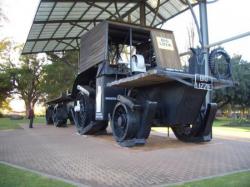
|
10 - Frank Bottrill (1871-1953), Richmond, Melbourne improved the Boydell system. It took a patent in 1906, ‘improved vehicle wheel, especially for steam engines traction machines, the 'Bottrill Dreadnought'. He doubled the mobile skid row, staggered and restrained them by cables to move more regularly. He made several trucks but the most famous, which he drove, called 'Big Lizzie' in 1915, the biggest of his time with Blackstone oil engine of 60 hp and a total mass of 45 tons unload and a total of 80 tons with two trailers. The larger wheels were 2.2 m in diameter and length of the vehicle alone was 10.2 m for a turning radius of 60 m and a maximum speed of 4 km / h. With 19,000 liters of fuel, Bottrill could run for three years. He cleaned intensively the sandy soil of Red Cliff, Australia, until 1928, and Big Lizzie was abandoned until 1971. In 1988, it was exposed to the public after restoration at Red Cliff. http://home.vicnet.net.au/~rcdhsoc/lizzy.html
|

|
11 - Even after the rise of the track, some thought to further improve the wheel with simpler means. On the left, a crown wheel on forestry tractor, simple way to increase the bearing surface and traction. David Hansen Technologies Iguana, Ilwaco, Washington, also built by a band fitted around the tires of the Jeep. http://www.fao.org/docrep/c3200e/c3200e0a.htm and http://iguanatrackedvehicles.com/
|
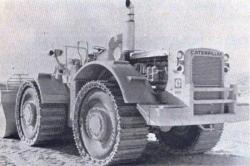
|
12 - Caterpillar resumed the idea of the crown wheel he named Dystred and marketed it in May 1971 on a CAT 988. The drive torus (the inner tire) was a special design. Improved protection against punctures, traction and stability did not prevent the chains (for example Erlau, Aalen), more economical, to take over. Pict from review 'Equipement Mécanique, Carrières et Matériaux' December 1972.
|
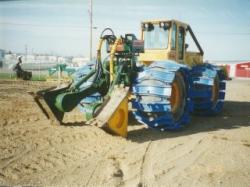
|
13 - The steel envelopes of wheels Hultdins of Olofsfors AB, Sweden and Brantford, Ontario, took the same idea by mounting a kind of plates on the wheels of a skidder equipped with a stump device Donaren H 870 Mounder. This supplier manufactures enclosures wheel Eco-wheels and forestry tracks Eco-tracks. http://www.eco-tracks.com/ECO-Tracks_?ptid=4748 http://www.hultdins.com/
|
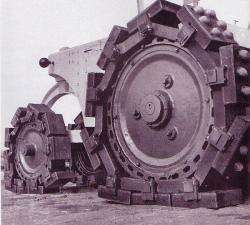
|
14 - Weiherhammer used the Koppisch system in the early 50 on two compactors including the largest, weighing 25 t to 70 hp, represented an alternative to the roller ‘sheep foot ' : it can be indeed seen the protuberances on each pad. Pict from 'History of Road Building Equipment' by Francis Pierre and Heinz-Herbert Cohrs, KLH International Ltd, 1998.
|
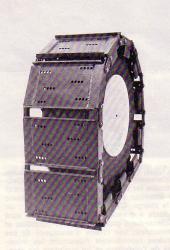
|
15 - Erlau steel belt in 1972, based on a similar system, wrapped around the tire. It allowed to help a stuck vehicle. From review 'Revue du Matériel d'Entreprise', January 1972.
|
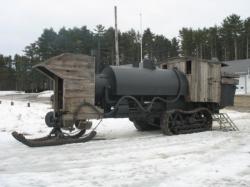
|
16 - But it was in 1901 that everything started really ! Alvin O. Lombard (1856-1937) built in series and sold this year the first traction engine equipped with crawler at Waterville Iron Works in Waterville, Maine. It was the 20 t Lombard Steam Log Hauler able to take 300 tons (double 22 sleds) at 7 km / h maximum. In all, 83 Log Haulers were constructed from 1901 to 1917 of which two are now in the Lumberman's Museum in Patten, Maine. Phoenix Centipede Company built them under license. In 1911-12, the Traction Engine Company Lombard Log Hauler developed a 6-cylinder petrol engine with 100 hp less heavy than the previous model. http://bangshift.com/blog/bangshift-poll-which-bangshifty-weekend-assignment-would-you-choose.html
|
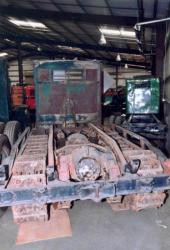
|
17 - Manufacturing Company Linn, Morris, New York, created by Holman Harry Linn, made 2500 suspended flexible steel crawler half-tracks, between 1917 and 1952. It was an expert of snow removal, working in forests and mining, dams and even in Arctic exploration. He helped maintain the Panama Canal. Here is an elevated rear view of the Lynn truck at Heidrick Museum in Woodland near Sacramento (California) in June 2001. Pict J M Maclou.
|

|
18 - In 1903, Benjamin Holt bought $ 60,000 to Alvin Lombard right to produce caterpillars in Stockton, California.
Meanwhile, in England at Grantham, David Roberts (1859-1928) chief engineer at R. Hornsby & Sons had patented a track in 1905 and built a very elaborate caterpillar tractor (picture) he failed in selling either the civil or the British Army. Benjamin Holt of Holt Manufacturing Company, Stockton, California, already well-established in the USA, saw all the profit he could extract and bought the patent in 1914. He equipped his own tractor with Hornsby brakes steering system, very good progress thus removing the tiller steering wheel. The British Army, bought more than 40 next year. Holt sold so well his tractors that he teamed with his best competitor C. L. Best of the Best Tractor Co., San Leandro, California, to create in 1925 the Caterpillar Tractor Company.
Therefore, the development of crawlers, associated with the dozer blade, made a dazzling leap in all industrialized countries that produced crawlers of very numerous forms and brand , especially after the Second World War. Caterpillar introduced even in 1977 the elevated sprocket witch, combined with roller supports on balance, allowed to increase traction and facilitate repairs while protecting the final drive. Picture taken at Bovington Museum by J M M in September 1994.
|
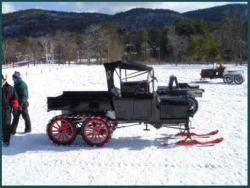
|
19 - Virgil D. White, Ossipee, New-Hampshire, Ford dealer, built his first Ford conversion, the 'Snowmobile' in 1913, patented in 1917 and produced in 70 copies in 1923. The conversion of the Ford Model T was sold only at Ford dealers. The front wheels were used in the muddy and sandy terrains but in snow, skis replaced them. The Farm Specialty Manufacturing Company of New Holstein, Wisconsin, bought the rights in 1925 and manufactured 3300 Snowmobiles per year until its closure in 1929. Pict Internet.
|
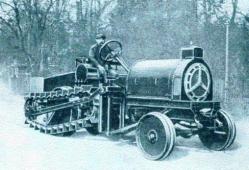
|
20 - Edmond François Lefevre, France, created a three-wheeled tractor of 2.2 t in 1913 for plowing. It presented a particular feature : they could lower two additional tracks in case of loss of traction.
Pict from book of Jean Noulin : 'Histoire des tracteurs à chenilles en France', ETAI, 92100 Boulogne, 1997.
|

|
21 - In 1913, A. Kegresse, director of the garages of the Czar of Russia, had already proposed its rapid flexible strip (first leather then rubber) developed for travel in snow and roads. Back in France, the famous expeditions on
semi-tracked Citroën Kégresse made him known worldwide. Picture of J M M at Schlumpf Museum in Mulhouse, in February 2004.
|

|
22 - Lieutenant Colonel Philips Johnson created in 1919 the ‘Roadless Traction Limited’. He made many Track Conversions on Ford tractors but, about 1920, studied and built in his Department of Tank Design and experiment the White Staff Observation Car (picture) with tracks and complex cable suspension for the U.S. Army. This company lasted until 1983. Pict from the book Roadless from Stuart Gibbard, Farming Press 1996.
|

|
23 - This Renault HI tractor constructed from 1920 to 1927 included articulated links crawler frames. Picture taken by J M Maclou at Rétromobile, Paris, February 2004.
|
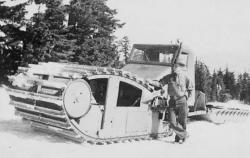
|
24 - Ted P. Flynn worked between 1923 and 1950 at the Forest Service in Portland, Oregon where he directed the Laboratory of Equipment of this service from 1936. Very fruitful, he invented and built numerous facilities for the forest : winches, small transport vehicles on forest trails, wheelbarrow saw, dozer blade angle on small tractor Clark adopted during the Second World War by the U.S. Army. These 'small' materials should be able to move on narrow forest tracks, especially in case of fire.
For transport on snow in the mountains, which also depended on the Forest Service, Ted Flynn studied with Raymond E. Neils the 'Sno-Motor' in 1938, the first truly efficient vehicle on snow, directed by articulation with a sled in the back (photo). The sled could carry 25 skiers on the slopes of Mount Hood and another was planned for the winters of Sun Valley as a ski lift or rescue. In 1948-49, this model was used to rescue herds in Cedar Valley after a storm. Based on a patent of Davidson filed in 1935, that probably also inspired Ted Flynn, another contemporary embodiment built by T. H. Brunius resumed the same principle of one (or two) tracks surrounding the engine.
In 1944, 36 of these vehicles, this time without sleds and many changes, called 'Iron Man T36 Fire Snow Tractors', made in Portland, Oregon, were purchased in 1944 by the U.S. Army and some sent in Alaska.
There are still wrecks of these vehicles to Cedar City, Utah, where their shape was familiar, but none of these typical vehicles of the region seems unfortunately restored or preserved. Pict from the book :
'Timberline Lodge: The History, Art, and Craft of an American Icon' of Sarah Baker Munro.
|
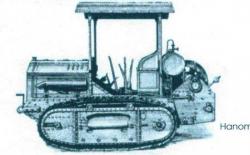
|
25 - The company was founded in 1835 : Georg Egestorff Hanomag Iron and Mechanical Engineering Works in Linden, near Hanover. This Hanomag Z 25 tractor dates from 1924. The company changed hands several times before becoming Komatsu Hanomag Ag in 1995.
Pict from the book of Richard H. Robinson : ‘ Crawler Tractor Scrapbook’, Part Three, Country Life Ltd, New Zealand, 2001.
|
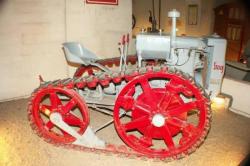
|
26 - Stock Raupe RA (1912-1940), Berlin, released in 1928 the Raupenstock of 26/28 hp. This one was pictured at the Maurice Dufresne Museum , Azay-le-Rideau, France, by J M M in 2004.
|
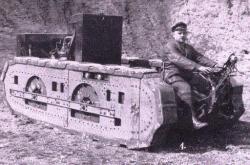
|
27 - Wotan-Werke Type A Tractor, Leipzig, Germany, whose studies were performed with Daimler-Benz Berlin-Mareinfelde in 1926.
Pict from book of Walter Spielberger ‘Die Rad –und volketten-zugmashinen des Deutschen Heeres’, 1871-1945, Part 10, Motorbuch Verlag, Stuttgart, 1989.
|
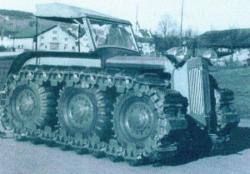
|
28 - The Swiss Hurliman, MS 70 hp model in 1938.
Pict from the book of Richard H. Robinson : ‘ Crawler Tractor Scrapbook’ Part Three, Country Life Ltd, New Zealand, 2001.
|
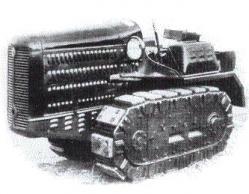
|
29 - Uranus Tractoren AG, Switzerland, produced in the late 30s a 40 hp tractor with sealed rigid caterpillar of a new kind and used by other manufacturers after the Second World War. The manufacturers argued that this system, sealed and impervious to dust made it possible to increase the speed of 16 km / h and the life of caterpillars. The photo shows a St Chamond Uranus Faure winemaker tractor, type UT 125 in 1947-49.
Pict from book of Jean Noulin : 'Histoire des tracteurs à chenilles en France', ETAI, 92100 Boulogne, 1997.
|
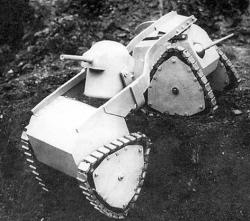
|
30 - Amadeus Varlet, Head of Research and Developments for Delahaye in 1918, conceived in 1937 that original Varlet tank 9 m long and 2.4 m wide to a height of 2.7 m. Nevertheless, only this scaled model was built. Its propulsion system and chassis in two parts gave flexibility to the whole. From aviamor.net
|
| |
|
| |
|






























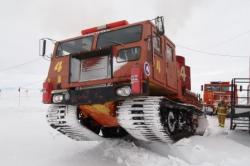
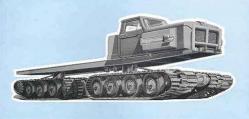
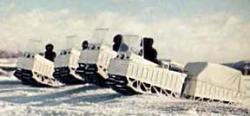
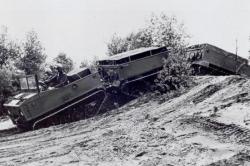
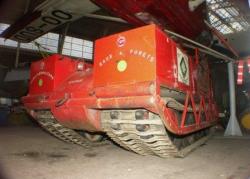
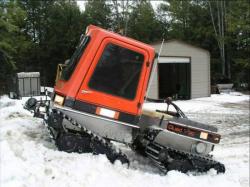
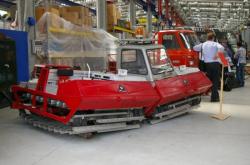
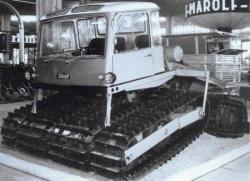
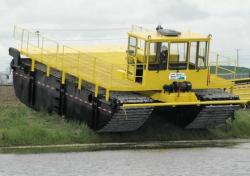
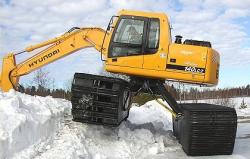
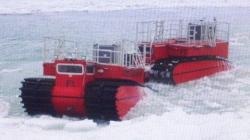
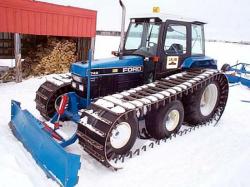
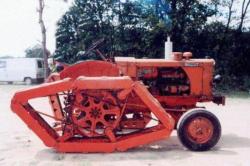
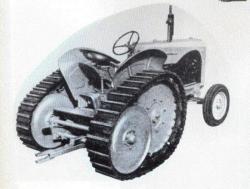
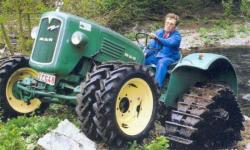
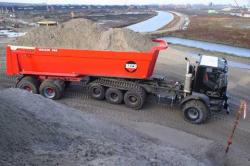

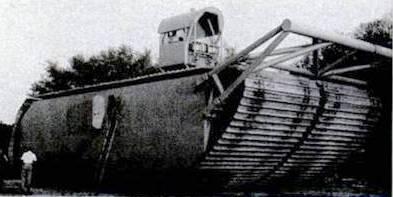
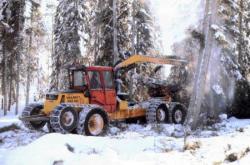
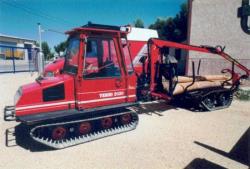
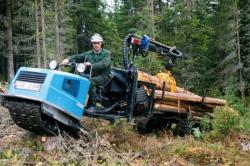
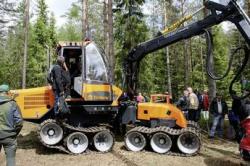
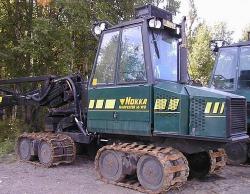
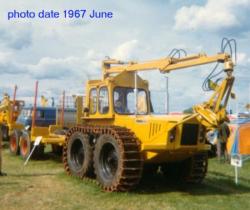
 Français
Français
 English
English
 Español
Español
 Italiano
Italiano
 Deutsch
Deutsch
 Nederlands
Nederlands
 Portuguesa
Portuguesa